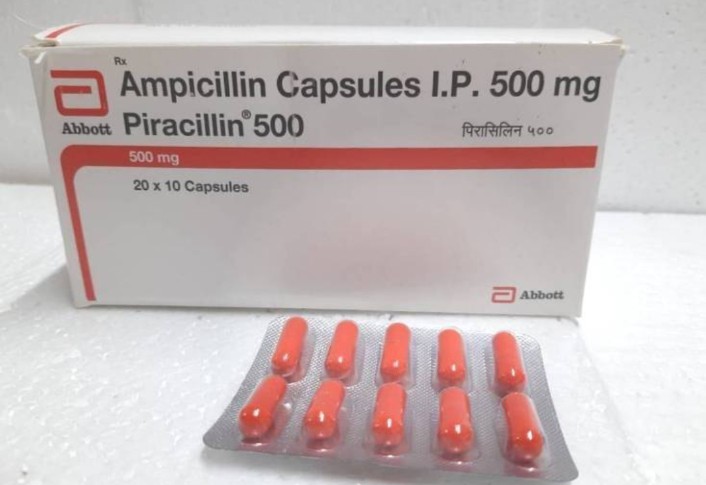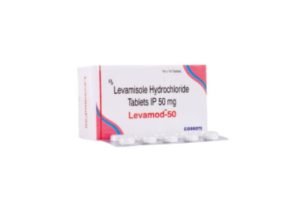
Here’s a detailed review of Ampicillin, a broad-spectrum penicillin antibiotic:
Description:
Ampicillin is a beta-lactam antibiotic in the penicillin group. It works by inhibiting bacterial cell wall synthesis, which leads to the destruction of bacteria. Ampicillin is effective against both Gram-positive and Gram-negative bacteria, making it a broad-spectrum antibiotic. It is commonly used to treat a variety of infections.
Brand Names:
- Omnipen
- Principen
- Totacillin
- Penbritin
- Ampimax
Available Forms & Strengths:
- Capsules: 250 mg, 500 mg
- Oral Suspension: 125 mg/5 mL, 250 mg/5 mL
- Injectable (IV/IM): 250 mg, 500 mg, 1 g, 2 g, and 10 g powder for reconstitution
Uses:
Ampicillin is used to treat various bacterial infections, including:
- Respiratory Tract Infections: Bronchitis, pneumonia, sinusitis, and pharyngitis.
- Urinary Tract Infections (UTIs).
- Gastrointestinal Infections: Salmonella, Shigella, and enteric fever (typhoid fever).
- Bacterial Meningitis: Caused by susceptible bacteria like Neisseria meningitidis, Haemophilus influenzae, or Streptococcus pneumoniae.
- Endocarditis: Caused by susceptible bacteria (often in combination with other antibiotics).
- Septicemia: Blood infections caused by susceptible bacteria.
- Skin and Soft Tissue Infections.
- Enterococcal Infections.
- Listeriosis: Ampicillin is the first-line treatment for Listeria monocytogenes infections.
Side Effects:
- Gastrointestinal: Nausea, vomiting, diarrhea, abdominal pain.
- Allergic Reactions: Urticaria (hives), rash, itching, and in severe cases, anaphylaxis.
- Superinfections: Prolonged use can lead to overgrowth of resistant bacteria or yeast, leading to secondary infections like Clostridium difficile-associated diarrhea (CDAD).
- Hematologic: Eosinophilia, thrombocytopenia (low platelet count), anemia, and leukopenia (low white blood cell count) have been reported.
- Injection Site Reactions: Pain, redness, or swelling at the injection site.
- Liver Function: Mild, transient elevations in liver enzymes.
Dose:
- Adults:
- Oral: Typically 250-500 mg every 6 hours for infections, depending on severity.
- Intravenous/Intramuscular: For severe infections, 1-2 g every 4-6 hours.
- Children:
- Oral: Dosed based on weight, usually 50-100 mg/kg/day divided into 4 doses.
- IV/IM: For severe infections, 100-200 mg/kg/day divided into multiple doses.
- Duration: Typically 7-10 days but depends on the specific infection and its severity.
Contraindications:
- Hypersensitivity to Ampicillin or other penicillin antibiotics.
- Caution in patients with a history of severe allergic reactions to beta-lactam antibiotics (e.g., penicillin, cephalosporins).
Drug Interactions:
- Allopurinol: Concurrent use increases the risk of developing a rash.
- Oral Contraceptives: Ampicillin can reduce the efficacy of hormonal contraceptives, so alternative birth control methods should be used during antibiotic treatment.
- Probenecid: Can increase the levels of Ampicillin by reducing its excretion from the body, potentially increasing the risk of side effects.
- Aminoglycosides: Should not be mixed with ampicillin in the same IV solution due to inactivation of both drugs, though they are often used together in clinical practice for synergistic effects.
Warnings:
- Allergic Reactions: Ampicillin can cause allergic reactions, including anaphylaxis, which can be life-threatening. Discontinue use immediately if signs of an allergic reaction occur, and seek emergency medical help.
- Renal Impairment: Dosage adjustments are needed in patients with renal (kidney) impairment to avoid drug accumulation and toxicity.
- Clostridium difficile-associated diarrhea (CDAD): Prolonged or severe diarrhea during or after treatment could indicate a serious infection caused by C. difficile.
Special Considerations:
- Pregnancy: Ampicillin is classified as Category B for pregnancy. It is considered safe to use during pregnancy when prescribed by a healthcare provider.
- Breastfeeding: Ampicillin is excreted in breast milk in small amounts, but it is generally considered safe for breastfeeding women. However, infants should be monitored for any signs of allergic reactions or gastrointestinal disturbances.
- Pediatric Use: Ampicillin is commonly used in children, but dosing must be based on body weight and the severity of the infection.
Doctor Advised:
Always take Ampicillin as directed by your doctor. Complete the full course of the antibiotic even if you start feeling better to prevent the development of antibiotic-resistant bacteria. Inform your doctor if you have any history of drug allergies, especially to penicillin or other beta-lactam antibiotics. If any severe side effects, such as persistent diarrhea or rash, occur, contact your doctor immediately.
Conclusion:
Ampicillin is a widely used broad-spectrum antibiotic effective against a variety of bacterial infections, particularly those affecting the respiratory and urinary tracts, as well as serious conditions like bacterial meningitis and septicemia. It is generally safe, but allergic reactions and gastrointestinal disturbances are the most common side effects. It’s especially important to adjust the dose in patients with renal impairment and to monitor for potential superinfections.







